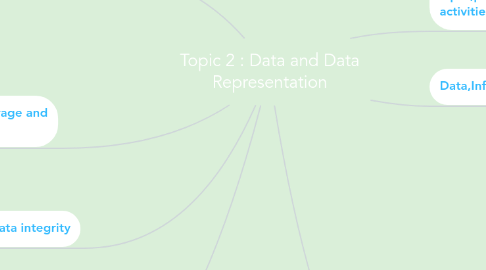
1. Processing-Data Coding
1.1. encoded assigning a bit pattern to each character,digit,or multimedia object
1.2. many standard exist foe encoding
1.2.1. character encoding like ASCII
1.2.2. image encoding like JPEG
1.2.3. video encoding like MPEG-4
2. Processing-Data Storage and Compression
2.1. reduce the size of data to save space or transmission time
2.2. lossy
3. Processing-Data integrity
3.1. security of protection data
3.2. involves access to files ( Access Control Lists)
3.3. protect files from being read,written,or to executed ; password protection
4. The Alphanumeric Representation
4.1. 3 alphanumeric codes are in common use
4.1.1. ASCII
4.1.1.1. each binary value between 0 and 127 represent a specific character
4.1.1.2. use the full range of 256 character available in a byte
4.1.2. Unicode
4.1.2.1. a worldwide character encoding standard
4.1.2.2. unique character,symbols
4.1.2.3. 16-bit standard
4.1.2.4. superset of ASCII
4.1.2.5. Extended Binary Coded Decimal Interchange Code developed by IBM
4.1.3. EBCDIC
4.1.3.1. character codes different from ASCII
5. Information processing cycle is the series of input,process,output,and storage activities
6. Data,Information and knowledge
6.1. Data
6.1.1. unprocessed facts and figures
6.2. Information
6.2.1. data that has been interpreted
6.3. Knowledge
6.3.1. information,experience and insight
7. Bits,Bytes<and Words
7.1. Number Bases
7.1.1. radix
7.1.1.1. when referring to binary,octal,decimal,hexademical,a single lowercase letter appended to identify its type
7.1.2. base
7.1.2.1. the number of different symbols required to represent any given number
7.1.2.2. the larger the base ,the more numerals are required
7.2. Binary system
7.2.1. used for both instruction and data
7.2.2. natural relationship between on/off switches and calculation using Boolean logic
7.2.3. represent these entities with number requires a system geared to the concept of on and off or true or false
7.2.4. a base 2 numbering system
7.2.5. each digit is either a 0(off) or 1(on)
7.3. Octal system
7.3.1. known as a base 8 numbering system
7.3.2. eight different digit available (0,1,2,3,4,5,6,7)
7.4. Decimal system
7.4.1. base a 10 numbering system
7.4.2. we use a system based on decimal digits to represent number
7.4.3. each digit in the number is multiplied by 10 raised to a power corresponding to that digit position
7.5. Hexadecimal System
7.5.1. a base 16 numbering system
7.5.2. used not only to represent integers
7.5.3. also used to represent sequence of binary digit

